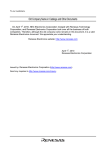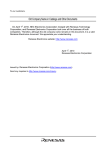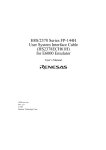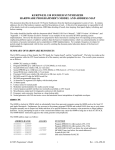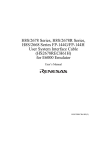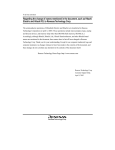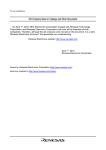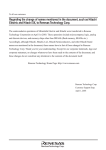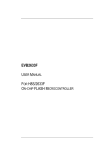Download Renesas H8S/2678R Series Technical information
Transcript
To our customers, Old Company Name in Catalogs and Other Documents On April 1st, 2010, NEC Electronics Corporation merged with Renesas Technology Corporation, and Renesas Electronics Corporation took over all the business of both companies. Therefore, although the old company name remains in this document, it is a valid Renesas Electronics document. We appreciate your understanding. Renesas Electronics website: http://www.renesas.com April 1st, 2010 Renesas Electronics Corporation Issued by: Renesas Electronics Corporation (http://www.renesas.com) Send any inquiries to http://www.renesas.com/inquiry. Notice 1. 2. 3. 4. 5. 6. 7. All information included in this document is current as of the date this document is issued. Such information, however, is subject to change without any prior notice. Before purchasing or using any Renesas Electronics products listed herein, please confirm the latest product information with a Renesas Electronics sales office. Also, please pay regular and careful attention to additional and different information to be disclosed by Renesas Electronics such as that disclosed through our website. Renesas Electronics does not assume any liability for infringement of patents, copyrights, or other intellectual property rights of third parties by or arising from the use of Renesas Electronics products or technical information described in this document. No license, express, implied or otherwise, is granted hereby under any patents, copyrights or other intellectual property rights of Renesas Electronics or others. You should not alter, modify, copy, or otherwise misappropriate any Renesas Electronics product, whether in whole or in part. Descriptions of circuits, software and other related information in this document are provided only to illustrate the operation of semiconductor products and application examples. You are fully responsible for the incorporation of these circuits, software, and information in the design of your equipment. Renesas Electronics assumes no responsibility for any losses incurred by you or third parties arising from the use of these circuits, software, or information. When exporting the products or technology described in this document, you should comply with the applicable export control laws and regulations and follow the procedures required by such laws and regulations. You should not use Renesas Electronics products or the technology described in this document for any purpose relating to military applications or use by the military, including but not limited to the development of weapons of mass destruction. Renesas Electronics products and technology may not be used for or incorporated into any products or systems whose manufacture, use, or sale is prohibited under any applicable domestic or foreign laws or regulations. Renesas Electronics has used reasonable care in preparing the information included in this document, but Renesas Electronics does not warrant that such information is error free. Renesas Electronics assumes no liability whatsoever for any damages incurred by you resulting from errors in or omissions from the information included herein. Renesas Electronics products are classified according to the following three quality grades: “Standard”, “High Quality”, and “Specific”. The recommended applications for each Renesas Electronics product depends on the product’s quality grade, as indicated below. You must check the quality grade of each Renesas Electronics product before using it in a particular application. You may not use any Renesas Electronics product for any application categorized as “Specific” without the prior written consent of Renesas Electronics. Further, you may not use any Renesas Electronics product for any application for which it is not intended without the prior written consent of Renesas Electronics. Renesas Electronics shall not be in any way liable for any damages or losses incurred by you or third parties arising from the use of any Renesas Electronics product for an application categorized as “Specific” or for which the product is not intended where you have failed to obtain the prior written consent of Renesas Electronics. The quality grade of each Renesas Electronics product is “Standard” unless otherwise expressly specified in a Renesas Electronics data sheets or data books, etc. “Standard”: 8. 9. 10. 11. 12. Computers; office equipment; communications equipment; test and measurement equipment; audio and visual equipment; home electronic appliances; machine tools; personal electronic equipment; and industrial robots. “High Quality”: Transportation equipment (automobiles, trains, ships, etc.); traffic control systems; anti-disaster systems; anticrime systems; safety equipment; and medical equipment not specifically designed for life support. “Specific”: Aircraft; aerospace equipment; submersible repeaters; nuclear reactor control systems; medical equipment or systems for life support (e.g. artificial life support devices or systems), surgical implantations, or healthcare intervention (e.g. excision, etc.), and any other applications or purposes that pose a direct threat to human life. You should use the Renesas Electronics products described in this document within the range specified by Renesas Electronics, especially with respect to the maximum rating, operating supply voltage range, movement power voltage range, heat radiation characteristics, installation and other product characteristics. Renesas Electronics shall have no liability for malfunctions or damages arising out of the use of Renesas Electronics products beyond such specified ranges. Although Renesas Electronics endeavors to improve the quality and reliability of its products, semiconductor products have specific characteristics such as the occurrence of failure at a certain rate and malfunctions under certain use conditions. Further, Renesas Electronics products are not subject to radiation resistance design. Please be sure to implement safety measures to guard them against the possibility of physical injury, and injury or damage caused by fire in the event of the failure of a Renesas Electronics product, such as safety design for hardware and software including but not limited to redundancy, fire control and malfunction prevention, appropriate treatment for aging degradation or any other appropriate measures. Because the evaluation of microcomputer software alone is very difficult, please evaluate the safety of the final products or system manufactured by you. Please contact a Renesas Electronics sales office for details as to environmental matters such as the environmental compatibility of each Renesas Electronics product. Please use Renesas Electronics products in compliance with all applicable laws and regulations that regulate the inclusion or use of controlled substances, including without limitation, the EU RoHS Directive. Renesas Electronics assumes no liability for damages or losses occurring as a result of your noncompliance with applicable laws and regulations. This document may not be reproduced or duplicated, in any form, in whole or in part, without prior written consent of Renesas Electronics. Please contact a Renesas Electronics sales office if you have any questions regarding the information contained in this document or Renesas Electronics products, or if you have any other inquiries. (Note 1) “Renesas Electronics” as used in this document means Renesas Electronics Corporation and also includes its majorityowned subsidiaries. (Note 2) “Renesas Electronics product(s)” means any product developed or manufactured by or for Renesas Electronics. To all our customers Regarding the change of names mentioned in the document, such as Hitachi Electric and Hitachi XX, to Renesas Technology Corp. The semiconductor operations of Mitsubishi Electric and Hitachi were transferred to Renesas Technology Corporation on April 1st 2003. These operations include microcomputer, logic, analog and discrete devices, and memory chips other than DRAMs (flash memory, SRAMs etc.) Accordingly, although Hitachi, Hitachi, Ltd., Hitachi Semiconductors, and other Hitachi brand names are mentioned in the document, these names have in fact all been changed to Renesas Technology Corp. Thank you for your understanding. Except for our corporate trademark, logo and corporate statement, no changes whatsoever have been made to the contents of the document, and these changes do not constitute any alteration to the contents of the document itself. Renesas Technology Home Page: http://www.renesas.com Renesas Technology Corp. Customer Support Dept. April 1, 2003 HS2678REPI61HE-P(B) Precautions on Using the H8S/2678R Series E6000 Emulator This section shows notes on using the H8S/2678R Series E6000 Emulator. 1 Precautions on Using the Emulator 1.1 Event ∙ Combination of Address-Range and Data Compare-Byte When an address range is set as the address condition and byte data as the data condition, a break will occur only at even addresses in the address range. When an address range is set as the address condition, do not set an odd address as the Address Lo condition. If set, a break will not occur even when the conditions are satisfied. 1.2 Memory Mapping Cannot map both emulator memory and user memory in the address area block below at the same time. If mapped, the previous mapped area changes to guarded area. Block name SB0 SB1 SB2 SB3 SB4 SB5 SB6 SB7 Address area H’000000-H’00FFFF H’010000-H’01FFFF H’020000-H’02FFFF H’030000-H’03FFFF H’040000-H’04FFFF H’050000-H’05FFFF H’060000-H’06FFFF H’070000-H’07FFFF Block name SB8 SB9 SB10 SB11 SB12 SB13 SB14 SB15 Address area H’080000-H’08FFFF H’090000-H’09FFFF H’0A000-H’0AFFFF H’0B0000-H’0BFFFF H’0C0000-H’0CFFFF H’0D0000-H’0DFFFF H’0E0000-H’0EFFFF H’0F0000-H’0FFFFF Block name LB0 LB1 LB2 LB3 LB4 LB5 LB6 LB7 Address area H’100000-H’1FFFFF H’200000-H’3FFFFF H’400000-H’5FFFFF H’600000-H’7FFFFF H’800000-H’9FFFFF H’A00000-H’BFFFFF H’C00000-H’DFFFFF H’E00000-H’FFFFFF 1.3 Memory Access During User Program Execution When the [Enable read and write on the fly] check box is valid in the Configuration Properties dialog box, which is displayed by selecting [Configure Platform…] from the [Setup] menu, memory access is enabled on the HDI during user program execution. However, this function cannot be used when the user program is in the sleep or standby state. 1.4 Temporary Breakpoint ∙ Run... (Run menu) Do not set temporary breakpoints to an area wherein PC Break (User Read-only) cannot be set. If set, user program execution will not stop at the breakpoint. Moreover, the On Chip Breakpoint may remain. In this case, delete the breakpoint from the [Breakpoints] window. 1.5 Bus Monitor The bus monitor function cannot be used in power-down modes. 1.6 Monitor ∙ Execution status display on status bar At memory access wait, not the address where access is halted, but the next fetched address is displayed. Note: Microsoft®, Windows®, Windows® 95, Windows® 98, Windows NT®, and Windows® 2000 are registered trademarks of Microsoft Corporation in the United States and/or other countries. 1/4 1.7 The Load/Save of the Session File Load the file after you confirm that the H/W environment is the same as that when the last session file was loaded. Note that the operation of HDI may become incorrect when Target Clock is chosen at the time when the session file was saved and Target was not connected at the time when the session file was loaded. 1.8 Load Memory During loading memory, if loading is stopped by [Halt] from the [Run] menu, there may be no responses from the HDI for a few seconds. For loading file, use [Load Program] from the [File] menu. 1.9 [Disassembly] Window At address specification to open the [Disassembly] window, when a value larger than the maximum one of the absolute address is input, the contents of the last address may not be displayed. In this case, do not perform scrolling with the scroll box on the scroll bar in the [Disassembly] window. If nothing is displayed on the Code or Assembly column in the [Memory] window or [Disassembly] window, close and open again the [Memory] window or [Disassembly] window. 1.10 [Trace] Window ∙ ∙ ∙ Note when the Number of Acquired Records is 1 When the number of acquired trace records is 1, the trace result may not be displayed on the [Trace] window. If no data is displayed on the [Trace] window even if "Trace - 1 record (no filter)" is displayed on the title bar in the [Trace] window, open the [Trace] window again. When the trace is acquired with the trace window opened and when the number of acquired records is 1, the displayed data is illegal. Update the data by reopening the [Trace] window. Note when Time Stamp Setting is Changed Even if the valid/invalid setting for the Time Stamp is switched in the [Trace Acquisition] dialog box, the header character string in the [Trace] window is not changed. When the valid/invalid setting is switched, open the [Trace] window again. Filter When the trace filter function is used, the information of the Address and Source columns in the [Trace] window does not match. When the filter function is used, ignore the source information displayed on the Source column. 1.11 [Memory Mapping] Dialog Box Even if the [Reset] button is clicked, the mapping information is not reset to the default setting. When the mapping information is reset to the default setting, once close the [Memory Mapping] dialog box with the [Close] button after clicking the [Reset] button. 1.12 Note on Setting Change Operation from BP Column When the execution time measurement start point (+Time) or trace start point (+Trace) is clicked with the right mouse button, a pop-up menu is displayed. An item in this pop-up menu may not be changed to another one. In this case, change the item with double-clicking or from the [Breakpoints] window or [Trace] window directly. 1.13 Note on [Registers] Window Operation during Program Execution During program execution, when the [Registers] window is double-clicked, a dialog box to change the register contents is displayed. However, the operation to change the register contents during program execution becomes invalid. 1.14 [Breakpoints] Window During user program execution, it is impossible to jump to the corresponding source line or address line on the [Source] or [Disassemble] window from a breakpoint by using Go to Source in the pop-up menu that is displayed on the [Breakpoints] window. 2/4 1.15 Profile Function The E6000 HDI does not support the profile function (section 13.10, Profile-List, section 13.11, ProfileTree, and section 13.12, Profile-Chart, described in Hitachi Debugging Interface User's Manual). 1.16 [I/O Registers] Window The E6000 HDI does not support the invalid module display and bit information display in the [I/O Registers] window (described in section 8, Displaying Variables, in the Hitachi Debugging Interface User's Manual). 1.17 Compare Memory The Compare Memory function, which can be used by selecting [Compare…] from the [Memory] menu, is not supported. 1.18 [Select Function] Dialog Box The E6000 HDI does not support software breakpoint setting in the [Select Function] dialog box (described in section 10, Selecting Functions, in the Hitachi Debugging Interface User's Manual). 1.19 Note on Radix in [Register] Dialog Box The default input radix in the [Register] dialog box is hexadecimal regardless of the Radix setting. If you want to input the radix other than hexadecimal, specify the prefix code such as B'. 1.20 Note on Moving Source File Position after Creating Load Module When the source file is moved after the load module has been created, the [Open] dialog box, which specifies the source file, may be displayed during debugging the created load module. Select the corresponding source file and click the [Open] button. 1.21 Source-Level Execution ∙ ∙ Source file Do not display source files that do not correspond to the load module in the program window. For a file having the same name as the source file that corresponds to the load module, only its addresses are displayed in the program window. The file cannot be operated in the program window. Step Even standard C libraries are executed. To return to a higher-level function, enter Step Out. In a for statement or a while statement, executing a single step does not move execution to the next line. To move to the next line, execute two steps. 1.22 Watch ∙ ∙ ∙ Local variables at optimization Depending on the generated object code, local variables in a C source file that is compiled with the optimization option enabled will not be displayed correctly. Check the generated object code by displaying the [Disassembly] window. Variable name specification When a name other than a variable name, such as a symbol name or a function name, is specified, no data is displayed. Example: The function name is main. main = Array display When array elements exceed 1000, elements from after 1000 will not be displayed. 1.23 Line Assembly ∙ Input radix Regardless of the Radix setting, the default for line assembly input is decimal. Specify H’ or 0x as the radix for a hexadecimal input. 3/4 ∙ Address space size In absolute addressing mode, specify the size (:16, etc.) 1.24 Command Line Interface ∙ ∙ Batch file To display the message “Not currently available” while executing a batch file, enter the sleep command. Adjust the sleep time length which differs according to the operating environment. Example: To display “Not currently available” during memory_fill execution: sleep d’3000 memory_fill 0 ffff 0 Overwrite file In Command Line Interface, a file having the same name as the output file is overwritten without asking the user. 1.25 Usage with Another HDI ∙ ∙ Automatic load of session files Since the emulator cannot use another HDI, re-install this HDI whenever another HDI has been previously installed is used. If another HDI has been used, initiate this HDI with "Run" as follows without using the session files. <Directory path name in which HDI is installed>\hdi /n (RET) /n initiates the HDI without loading the recently used session files. If there is another session file in the different debug platform, the following error message is displayed: invalid target system: <recently used debug platform name> Uninstallation of Another HDI When another HDI is uninstalled after installing this HDI, the bus monitor function and the stack trace function cannot be used. To use this function, re-install this HDI. 1.26 Limitations when Using Old Version of Windows 95 When using the old released version (4.00.950a, etc.) of Windows 95, an illegal operation may occur; for example, the HDI is abnormally terminated by an application error if [Options…] is selected from the [Setup] menu. This is because of the old version of COMCTL32.DLL in the System directory in the Windows directory. Download the updated program of COMCTL32.DLL from the Microsoft homepage, or update the version of Windows 95. 2 User's Manual 2.1 Emulator User's Manual In the E6000 emulator user's manual, some screen bitmap may be different from actual ones. For details on functions, refer to the on-line help or Hitachi Debugging Interface User's Manual. 2.2 Execution Environment of the Tutorial Program When the tutorial program is executed, after [E6000 H8S/2678 Emulator] is selected in the [Select Session] dialog box and the HDI is started, select [Configure Platform...] from the [Setup] menu, and then set the followings according to the Configuration dialog box to be displayed. Option Set Value Device H8S/2676 Mode 7 (On-Chip ROM, Single Chip) Clock 12.5 MHz Timer Resolution 125 ns Others Default 4/4








